

Original Article - Year 2005 - Volume 20 -
Early active mobilization after flexor tendon repair in zone 2
Mobilização Pós-Operatória com Flexão Ativa Precoce Após Reparo de Tendões Flexores na Zona 2
ABSTRACT
Background: The first cause of bad results after flexor tendon repair is scar adhesions. An early mobilization protocol could help to reduce those adhesions under the increased risk of tendon rupture. This study aims to evaluate the functional results after flexor repair in zone 2. Method: A number of 136 hand flexor tendons were repaired in zone 2, in a total number of 82 patients, all of them with only one finger affected, with a total rupture of both flexor tendons in the case of long fingers or the flexor pollicis longus in the case of thumb, managed under an early active flexion -extension protocol. The results were based on both the International Federation of Societies for Surgery of the Hand (IFSSH) and the Strickland's systems of evaluation. The results of long fingers and thumbs were analysed separately. Results: The results of the long fingers group were excellent (72.2%), good (26.0%) and fair (1.9%), according to the Strickland's standards and were good (81.5%), fair (16.6%) and poor (1.9%), according to the IFSSH standards. The results of the thumbs group were excellent (96.4%) and fair (3.6%), according to the Strickland's standards and were excellent (82.1%), good (14.3%) and poor (3.6%), according to the IFSSH standards. A rupture rate was 6.09%, nevertheless functional results of reoperated patients was satisfactory. Conclusions: This study corroborates evidence that postoperative programs that incorporate early active motion (flexion/ extension) can produce good results after flexor tendon repair in zone 2 in a single digit injury.
Keywords: Tendon injuries, surgery, rehabilitation. Finger injuries, surgery, rehabilitation
RESUMO
Introdução: A primeira causa de maus resultados após uma reparação de tendão flexor em zona 2 é a formação de aderências. Um protocolo de mobilização precoce poderia ajudar a diminuir tais aderências, sob risco de aumentar a taxa de rupturas. Este estudo objetiva avaliar o resultado funcional do reparo de lesões de flexores na zona 2. Método: Foram tratados 136 tendões flexores da mão, na zona 2, em 82 pacientes, todos com lesões unidigitais, com secção completa de ambos os tendões, no caso dos dedos largos, o do flexor pollicis longus, no caso de polegar, submetidos a um protocolo de flexão e extensão ativa precoce. Os resultados foram classificados segundo a International Federation for Societies for Surgery of the Hands (IFSSH) e pela classificação de Strickland. Resultados: Os resultados funcionais dos dedos longos foram excelentes (72,2%), bons (26,0%) e regulares (1,9%), de acordo com a classificação de Strickland e bons (81,5%), regulares (16,6%) e pobres (1,9%), segundo a classificação da IFSSH. Os resultados do polegar foram excelentes (96,4%) e regulares (3,6%), de acordo com a classificação de Strickland e excelentes (82,1%), bons (14,3%) e pobres (3,6%), de acordo com a classificação da IFSSH. A taxa de ruptura foi de 6,09% ; não obstante, os resultados funcionais dos pacientes reoperados foram satisfatórios. Conclusões: O presente estudo sugere que o protocolo de mobilização ativa precoce no pós-operatório das tenorrafias de flexores da mão em zona 2 pode proporcionar bons resultados funcionais em lesões no dedo único.
Palavras-chave: Traumatismo dos tendões, cirurgia, reabilitação. Traumatismo dos dedos, cirurgia, reabilitação
A causa mais freqüente de insucesso após um reparo de tendão flexor é a formação de aderências. Na zona 2, isto é particularmente evidente, porque nela se encontram os dois tendões flexores em íntimo contato deslizando em um estreito canal osteofibroso. Os resultados funcionais têm melhorado significativamente nas últimas décadas. Este fato deve-se em muito a programas de mobilização precoce pós-operatória que diminuem a formação de aderências peritendinosas devido ao deslizamento dos tendões e em relação aos tecidos circunjacentes. Os protocolos de mobilização que utilizam a flexão ativa precoce são alvos de críticas, pelo maior número de rupturas no pós-operatório precoce. A maioria dos cirurgiões utiliza protocolos de mobilização precoce passiva ou com flexão passiva e extensão ativa, os quais apresentam resultados satisfatórios e previsíveis, quando bem conduzidos por profissionais com experiência em reabilitação da mão. No entanto, vários autores sugerem que protocolos que incluam a flexão ativa precoce podem ter resultados comparáveis e diminuir complicações como aderências, deformidade em flexão e déficit de extensão1-6.
Este estudo objetiva avaliar o resultado funcional do reparo de lesão de flexores na zona 2 em pacientes submetidos a um protocolo de mobilização que incluiu flexão ativa pós-operatória imediata.
MÉTODO
A população deste estudo é composta por 82 pacientes (136 tendões) que sofreram ruptura dos tendões flexores na zona 2. Após a tenorrafia, um protocolo de mobilização ativa foi iniciado 12 horas após a cirurgia.
Foram incluídos os pacientes com secção completa de ambos os tendões flexores - superficial e profundo - dos dedos longos (indicador, médio, anular e mínimo) e com secção completa do flexor longo no caso do polegar. Os pacientes que apresentavam lesão em apenas um dos tendões flexores, lesão multidigital, fraturas, laceração dos extensores, lesão articular e perda de substância (tendinosa, cutânea ou nervosa) foram excluídos do estudo.
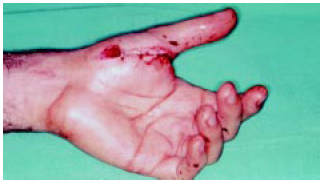
Figura 1 - Lesão do flexor longo do polegar.
A idade dos pacientes variou de 19 a 64 anos (média 29). Secção por faca foi o mecanismo de lesão predominante (61,1%).
Todas as tenorrafias foram realizadas entre janeiro de 1997 e janeiro de 2003. O período de seguimento mínimo foi de 12 meses (Tabela 1).
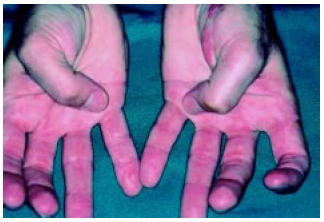
Figura 2 - Resultado comparativo, seis semanas de pós-operatório, flexão total.

Figura 3 - Resultado comparativo, seis semanas de pós-operatório, extensão total.
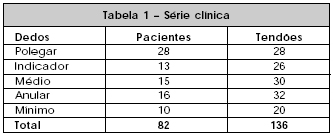
Técnica Operatória
Todas as tenorrafias foram realizadas sob bloqueio axilar e garrote pneumático.
O acesso às lesões foi feito através de incisão palmar em "zig-zag", descrita por Brunner. A técnica de tenorrafia utilizada foi a de Kessler modificada ("Nylon" 3.0) associada a uma sutura epitendinosa contínua ("Nylon" 5.0). Ambos flexores profundo e superficial foram reparados em todos os casos. As polias A2, A3, e A4 foram prioritariamente preservadas. A bainha tendinosa foi reposta sobre o reparo tendinoso, mas não foi suturada.
Pós-operatório
Uma tala gessada dorsal da extremidade dos dedos até logo abaixo do cotovelo foi confeccionada mantendo o punho em aproximadamente 30 a 60 graus de flexão, a metacarpofalangeana em 90 graus, e as interfalangeanas em 0 grau. Um protocolo de mobilização ativa precoce foi iniciado 12 horas após a cirurgia. Os pacientes foram instruídos a realizar 10 movimentos de flexão-extensão por hora, 16 horas por dia. A orientação foi de realizar a extensão preferencialmente passiva e prestar especial atenção para realizar a flexão do dedo operado ativamente. Todos os pacientes foram orientados para entrar em contato com a equipe médica prontamente em caso de perda súbita de flexão ou qualquer outra anormalidade. Nos casos de deiscência, o paciente foi submetido a nova tenorrafia imediata e orientado para realizar o mesmo protocolo pós-operatório da primeira cirurgia. Em todos os casos, a tala foi retirada após 3 semanas. As revisões ambulatoriais foram semanais durante o primeiro mês.
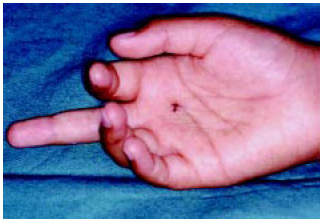
Figura 4 - Lesões de ambos os tendões flexores (superficial e profundo).
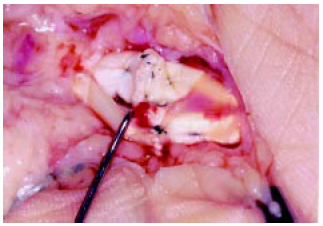
Figura 5 - Sutura de ambos os tendões.
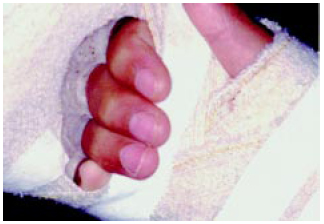
Figura 6 - Flexão pós-operatória.
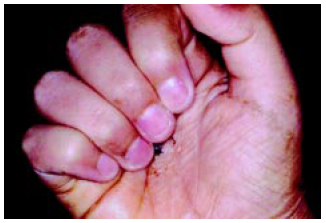
Figura 7 - Resultado em três semanas.

Figura 8 - Resultado em cinco semanas.
RESULTADOS
Os resultados foram medidos com 12 meses de pós-operatório. Os casos foram avaliados segundo a classificação da International Federation of Societies for Surgery of the Hand (IFSSH) e a classificação modificada de Strickland (Tabelas 2 a 5).
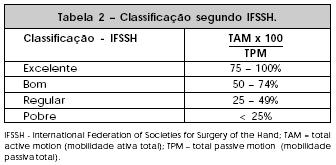
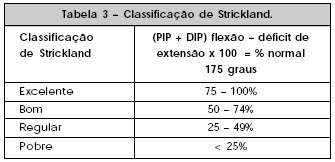
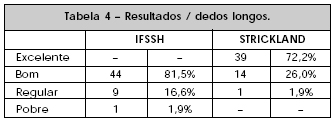
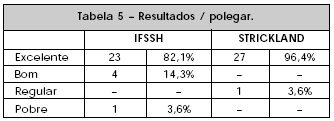
Cinco (6,09%) casos de ruptura foram observados, todos ao nível da linha de sutura e depois da segunda semana de mobilização ativa. Após a reintervenção, os pacientes mantiveram o mesmo programa de reabilitação, porém, sendo orientados e monitorados mais cuidadosamente. Em nenhum dos casos de toda a série houve a necessidade de tenólise, no pós-operatório tardio. Os resultados dos pacientes que sofreram ruptura podem ser vistos na Tabela 6.
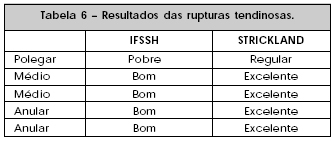
DISCUSSÃO
Longos períodos de imobilização após uma tenorrafia, sobretudo na zona 2, sabidamente provocam níveis inaceitáveis de aderências tendinosas e, conseqüentemente, resultados desanimadores. Devido a isto, vários protocolos de mobilização precoce foram desenvolvidos nas últimas décadas, melhorando significativamente o resultado final das tenorrafias7-10. Apesar da mobilização precoce provocar um índice maior de rupturas no pós-operatório imediato, existem dados experimentais demonstrando uma melhor qualidade de reparo tendinoso11. Manske12 sugeriu que o estresse mecânico provoca a estruturação das fibras de colágeno, diminui a formação de aderências e aumenta a força tênsil devido à predominância da atividade intrínseca na cicatrização tendinosa.
Em 1960, Young e Harmon7 descreveram um programa de mobilização precoce passivo baseado na tração dinâmica em flexão. Durante as décadas subseqüentes, as técnicas de mobilização "flexão passiva - extensão ativa", denominadas generalizadamente de protocolos de Kleinert, alcançaram grande aceitação entre os cirurgiões. Estas técnicas ainda são muito utilizadas e diversas modificações foram descritas em estudos mais recentes13-15.
Os programas de mobilização com flexão ativa precoce apresentam um risco a mais no que diz respeito à deiscência, pois submetem a sutura tendinosa a uma tensão maior e maior amplitude de movimento. Existem algumas evidências experimentais do beneficio da mobilização ativa sobre a cicatrização tendinosa. Becker1 sugere que os regimes de mobilização com flexão passiva e extensão ativa não seriam capazes de produzir um deslizamento tendinoso suficientemente satisfatório do local de sutura, privando o mesmo dos benefícios da tensão na cicatrização tendinosa. Manske12 sugeriu que a excursão tendinosa suficiente para prevenir aderências seria apenas obtida com a contração ativa do músculo. Alguns estudos clínicos mais recentes sugerem que a mobilização precoce com flexão ativa pode apresentar algumas vantagens sobre os métodos que utilizam a flexão passiva, nas primeiras semanas de pós-operatório. Haveria uma menor formação de aderências e melhores resultados no que diz respeito à deformidade de flexão e ao déficit de extensão1-6,12.
O tratamento fisioterápico ambulatorial do Sistema Único de Saúde é deficitário no que diz respeito ao atendimento da demanda e na agilidade de início do tratamento. Este fato faz com que inúmeros pacientes que necessitam de reabilitação precoce após o reparo de lesões tendinosas, assim como outros tipos de traumas da mão, fiquem completamente desprovidos de acompanhamento fisioterápico. Diante desta realidade e motivados pela insatisfação com os resultados obtidos com protocolos de flexão passiva (índices elevados de tenólise secundária), começaram a implementar um protocolo de mobilização precoce, incluindo flexão ativa desde o primeiro dia pós-operatório. Apesar de terem observado um número não desprezível de rupturas, o resultado funcional final tem sido considerado mais satisfatório e a necessidade de tenólise absolutamente reduzida a zero.
No presente estudo, os pacientes foram estimulados a iniciar os movimentos de flexo-extensão, no primeiro dia pós-operatório, protegidos por uma tala dorsal. Tal proteção ajuda a prevenir movimentos mais vigorosos e aumenta o conforto e a segurança dos pacientes.
Os resultados obtidos (98,2% bons ou excelentes, classificação de Strickland) são comparáveis a outros estudos que utilizaram flexão ativa precoce: Silfverkiöld5 e May (96,5%), Bainbridge6 et al. (94%).
A ruptura é a maior complicação dos protocolos de flexão ativa precoce. O receio de deiscência precoce é a principal razão pela qual a maioria dos cirurgiões não opte por este método de reabilitação. A taxa de 6,09% é consideravelmente alta. No entanto, o resultado final dos pacientes que sofreram ruptura foi bastante satisfatório. O resultado funcional foi tão bom quanto o das tenorrafias sem complicação. Outros autores já descreveram este achado2,6.
CONCLUSÕES
O presente artigo sugere que protocolos de mobilização precoce que incluam flexão ativa no pós-operatório recente de tenorrafia de flexores em zona 2 podem obter bons resultados funcionais (critérios da IFSSH e de Strickland). Atualmente, adota-se esse protocolo em todos os casos de reparo de lesões de flexores em nossa instituição.
REFERÊNCIAS BIBLIOGRÁFICAS
1. Becker H. Primary repair of flexor tendons in the hand without immobilisation: preliminary report. Hand. 1978;10(1):37-47.
2. Small JO, Brennen MD, Colville J. Early active mobilisation following flexor tendon repair in zone 2. J Hand Surg. 1989;14(4):383-91.
3. Cullen KW, Tolhurst P, Lang D, Page RE. Flexor tendon repair in zone 2 followed by controlled active mobilisation. J Hand Surg. 1989;14(4):392-5.
4. Savage R, Risitano G. Flexor tendon repair using a "six-strand" method of repair and early active mobilisation. J Hand Surg. 1989;14(4):396-9.
5. Silfverskiöld KL, May EJ. Flexor tendon repair in zone 2 with a new suture technique and an early mobilization program combining passive and active flexion. J Hand Surg. 1994;19(1):53-60.
6. Bainbridge LC, Robertson C, Gillies D, Elliot D. A comparison of post-operative mobilization of flexor tendon repairs with "passive flexion-active extension" and "controlled active motion" techniques. J Hand Surg. 1994;19(4):517-21.
7. Young RE, Harmon JM. Repair of tendon injuries of the hand. Ann Surg. 1960;151(4):562-6.
8. Duran RJ, Houser RG. Controlled passive motion following flexor tendon repair in zone 2 and 3. In: AAOS Symposium on tendon surgery in the hand. St. Louis:CV Mosby;1975. p.105-14.
9. Lister GD, Kleinert HE, Kutz JE, Atasoy E. Primary flexor tendon repair followed by immediate controlled mobilization. J Hand Surg. 1977;2(6):441-51.
10. May EJ, Silfverskiöld KL, Sollerman CJ. Controlled mobilization after tendon repair in zone II: a prospective comparison of three methods. J Hand Surg. 1992;17(5):942-52.
11. Gelberman R, Vande Berg JS, Lundborg GN, Akeson WH. Flexor tendon healing restoration of the gliding surface: an ultrastructural study in dogs. J Bone Joint Surg Am. 1983;65(1):70-80.
12. Manske PR. Flexor tendon healing. J Hand Surg. 1988;13(3):237-45.
13. Silfverskiöld KL, May EJ, Törnvall AH. Flexor digitorium profundus tendon excursions during controlled motion after flexor tendon repair in zone II: a prospective clinical study. J Hand Surg. 1992;17(1):122-31.
14. Silfverskiöld KL, May EJ, Törnvall AH. Tendon excursions after flexor tendon repair in zone II: results with a new controlled motion program. J Hand Surg. 1993;18(3):403-10.
15. Edinburg M, Widgerow AD, Biddulph SL. Early postoperative mobilization of flexor tendon injuries using a modification of Kleinert technique. J Hand Surg 1987;12(1):34-8.
I. Professor da Faculdade de Medicina da PUC-RS e Responsável pela Cirurgia da Mão e Microcirurgia Reconstrutiva do Hospital São Lucas da PUC-RS.
II. Professor da Faculdade de Medicina da PUC-RS e Regente do Serviço de Cirurgia Plástica do Hospital São Lucas da PUC-RS.
III. Estagiário da Unidade de Cirurgia da Mão e Microcirurgia Reconstrutiva do Hospital São Lucas da PUC-RS.
IV. Acadêmico da Faculdade de Medicina da PUC-RS.
Correspondência para:
Jefferson Braga-Silva
Av. Ipiranga, 6690, conj. 216 - Centro Clínico PUC-RS
Porto Alegre, RS, Brasil - CEP: 90610-000
Tel/Fax: 0xx51 3315-6277 - 0xx51 3320-5040
E-mail: jeffmao@terra.com.br
Trabalho realizado no Serviço de Cirurgia Plástica - Unidade de Cirurgia da Mão e Microcirurgia Reconstrutiva do Hospital São Lucas da PUC-RS, Porto Alegre, RS.
Artigo recebido: 04/07/2005
Artigo aprovado: 09/09/2005


 Read in Portuguese
Read in Portuguese
 Read in English
Read in English
 PDF PT
PDF PT
 Print
Print
 Send this article by email
Send this article by email
 How to Cite
How to Cite
 Mendeley
Mendeley
 Pocket
Pocket
 Twitter
Twitter